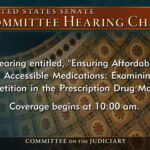The Threat to Preferred Pharmacy Networks
Alex Brill
Provider networks are a well-known tool health insurance companies use to keep down the cost of care. In-network doctors, hospitals, and other practitioners accept a lower fee in exchange for more volume, and patients pay a lower or no copay to see in-network providers. As a result, patients can save hundreds of dollars per year in out-of-pocket costs.
Similarly, but less widely known, pharmacy benefit managers (PBMs) keep prescription drug costs down by establishing preferred pharmacy networks. These networks were uncommon a decade ago, but by 2021 they were near universal in Medicare prescription drug plans and increasingly common among commercial plans. Patients’ out-of-pocket costs are generally lower when they fill a prescription at a preferred pharmacy compared with the cost either at a non-preferred pharmacy or when there is no preferred network in place.
Patient savings associated with preferred pharmacy networks can be considerable, especially for people with multiple chronic conditions, as monthly copays for most prescriptions are $6-$8 at preferred pharmacies. Within the Medicare population, the benefit is greater for beneficiaries who are not eligible for the low-income subsidy (LIS), as maximum copays for LIS beneficiaries are already lower than the copays within preferred pharmacy networks. For non-LIS patients (nearly 80 percent of Medicare beneficiaries), annual out-of-pocket savings can easily exceed $100 per year.
In a recent paper in The American Journal of Managed Care, Jianhui Xu, Erin Trish, and Geoffrey Joyce find that increased utilization of preferred pharmacies would result in greater savings. Specifically, non-LIS Medicare beneficiaries could save $94 annually on average by switching to a preferred pharmacy, while Medicare could save $170 per LIS beneficiary who switches to a preferred pharmacy. Given that tens of millions of people are enrolled in Part D but not using a preferred pharmacy, the potential annual savings are quite large: roughly $3 billion annually.
While the savings potential is large, there are some small costs that should be recognized. In a 2021 paper, Amanda Starc and Ashley Swanson calculated the average additional travel time required for a beneficiary to drive to the nearest preferred pharmacy as opposed to the nearest non-preferred pharmacy. The answer: 3.7 minutes. In rural communities, the average was 5 minutes; in the suburbs, 2.1 minutes. Of course, not all prescriptions are filled in person. Roughly 1 in 6 people filling prescriptions use a mail-order pharmacy, according to a 2021 paper by Duy Do and Pascal Geldsetzer.
Given the sizeable benefits and minimal costs of preferred pharmacy networks in Medicare Part D, it is surprising that Congress is considering policies that constrain the ability of PBMs to manage pharmacy networks. A recent proposal from the Senate Finance Committee would mandate that certain pharmacies, those deemed “essential retail pharmacies,” be eligible for participation, at their choosing, as preferred pharmacies. Moreover, the legislative proposal would set minimum reimbursement terms for these pharmacies, likely overriding the market-based arrangements established for other preferred pharmacies.
The consequences of such a policy? Pharmacies currently participating in a preferred network may no longer be willing to accept the terms (lower reimbursement in exchange for network participation) because they will not have the same increase in volume once the network expands to include additional participants. In other words, costs will rise, and the preferred pharmacy network design will be weakened.












